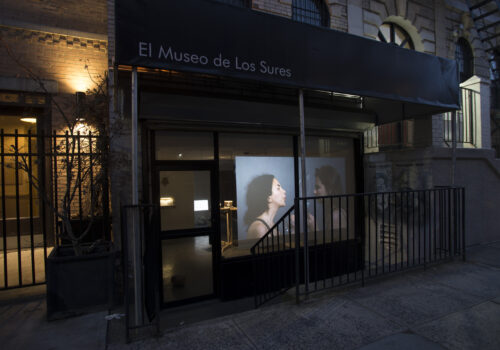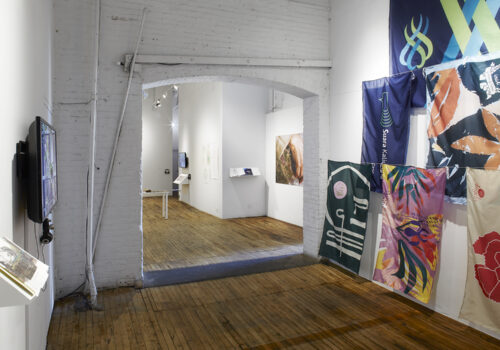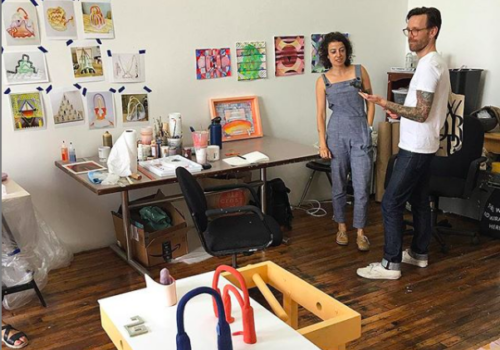Alibi of Autonomy. Susan Hapgood (SH): Cheon, hi. You have been here in residence at El Museo de Los Sures for how long? Cheon pyo Lee (CPL): I was in residence for roughly 4 months, from October 12, 2017, to January 24, 2018. SH: Could talk a little bit about what you did and how you connected to the neighborhood? CPL: When I first moved in, my plan was to host as many public events as possible on a small scale. I noticed that the space and location are good, but not enough events are happening. So, since the shutter is often down, people don’t know what the space is about although there is a big sign but it’s sometimes closed. I hosted and publicized a few events throughout the residency, but a lot of times, whenever I was in the studio working I would have the shutter up and the doors open. I also listed my studio hours in the project press release so people could just drop in and talk to me. The interesting part is that previous neighbors would just come in wanting to meet the new neighbor. So, they would talk a lot about the changes that happened in Williamsburg. And I used to have my studio in the early 2000s where the early developments are now. SH: Where is that? CPL: Just by the Williamsburg Bridge. There used to be a squat in the basement. There were about 50 artists living there, and many of them still live in the area now. They came in here and talked to me about the changes in the neighborhood. I would invite them back to the space when I had events, and I took their contact information to make sure they knew about them. SH: Were there many people who live in the different housing facilities of Los Sures that dropped by to see what was happening, too? CPL: Yeah! SH: Do you speak Spanish? CPL: I do speak Spanish. That probably helped. SH: I’m curious how often you were speaking Spanish and how often were you speaking English? CPL: I spoke Spanish whenever I got comfortable, really. I don’t want to assume that anyone speaks Spanish because a lot of younger generations – SH: Are bilingual. CPL: Yes, and they prefer English. But speaking Spanish definitely helps. It’s easy to connect that way. SH: So you were here, the days were like Tuesday to…? CPL: Tuesdays to Thursdays, from 11am to 7pm. SH: That is an amazing amount of time. CPL: I wanted to take advantage of the space. I was actually here more often than that to be honest. SH: Really? CPL: Yes. But those were the public hours that I had because sometimes I would be recording a video shoot and then I would close the door, obviously. But I felt that was a big part of the agreement that I had with ISCP when you invited me to do this, to be open and involve the people around here. SH: Well it is a big part. I mean one of the reasons ISCP is working with El Museo de Los Sures is to activate the community with contemporary art. Thank you very much for taking that so seriously. It’s a big responsibility. CPL: I do care. I live in Brooklyn and I do think it’s important that artists are more approachable. Surprisingly the neighborhood residents show a lot of interest. And they give you feedback which is very interesting, especially with my work, which is political and has a lot to do with geography. It was really useful to receive that feedback; the more formal comments I receive from other artists is very different. SH: Yeah, sure. And understanding what a non-art person sees is a really valuable thing, people who don’t necessarily know about the history of art and what’s happening in contemporary practice. CPL: Yeah, it made me rethink how I present my work and it was very humbling. SH: Interesting. Would you say that some of the people that stopped by went away with a very different, broadened understanding of what contemporary art could be, or what it could do? CPL: Definitely. Also, since my work is very collaborative, I think it was refreshing for them to ask: “your name is on the door but why do you have so many other artists working with you?” SH: Because artists are supposed to be individual hero geniuses, right? CPL: Yes, because that is the myth created. SH: Agreed. So, how many public events did you organize during your time here? CPL: I hosted four events. The very first one was about development–it wasn’t very complicated aesthetically. The theme was centered around upbringing and the American education system, with all male participating artists. This led to conversations about masculinity in today’s society and how fragile that is, really. Lately there is a lot of talk about feminism, which, I think, goes in part with the dialogue about masculinity. A lot of misogynists are fragile beings, mentally. I also hosted a video screening in second languages, which included performance videos and choreography. That was fun. I also curated a group show about landscape, and organized a book release. That was the last event. Some of the writers read passages and explained their project, and there was also a performance. SH: Did you get good attendance? CPL: Yes! Surprisingly so. SH: Did you get a mix of art people and neighborhood residents? CPL: Definitely many non-art attendees in the last event, probably because I had time to advertise that there would be an event happening in the area. Many neighbors came. I think the neighbors were still trying to figure out what was going in during the first couple of months of the residency. SH: It takes time. I think that the duration of your project has everything to do with it, too. One final question: I find very interesting the way you are so loose and open about what your practice is as an artist. All of the projects you’ve done during this residency–do you consider them to be a part of your practice as an artist? And if so, how do you capture that? It’s an impossible question but I’m still asking! CPL: As a young artist, I am still trying figure out my own language. Lately though, I do feel a sense of responsibility because of how much support I am receiving for my practice, both monetary support and the physical space that ISCP offered me here at El Museo de Los Sures. I think a lot of artists are becoming part administrator, part teacher and still fulfilling the romantic artist role. The combination of these three roles creates important artwork. This assimilation of positions was a process through which I started understanding how to care about fellow artists, as well as realize what more there is to learn. I ran the space so it was easier for me to explain the project to a more general audience, but since I am not a trained curator or teacher, doing so was humbling. And then again, there were times when I needed to be alone to develop my projects. All these elements definitely informed my practice. SH: So, would you say that what you just described captures the title of your residency Alibi of Autonomy? CPL: As a contemporary artist, my understanding of art is not just formal. This entire project was a way for me to understand the context and situation in which I work, to in turn better myself. SH: Amazing!]]>
Cheon pyo Lee and Susan Hapgood Discuss Alibi of Autonomy

March 15, 2018
by Susan Hapgood
Now it Can Be Anything: Mira Asriningtyas and Dito Yuwono in conversation with Kari Conte

April 03, 2020
by Kari Conte
Kari Conte: Firstly, what is LIR Space? Dito Yuwono: Now it can be anything. Mira Asriningtyas: It is an art space. It was a physical art space, but now it can be anything. It’s a movable institution. D: Yes, I agree. K: Can you speak about past LIR projects? How has the programming evolved into what it is today? D: LIR started with space in 2011—a physical space—which at first focused on young artists, and then on alternative education. In 2017, we started a project called 900mdpl, which is a site-specific project in Kaliurang, Indonesia. And in 2019, we decided to close our physical space and make the institution nomadic rather than a permanent institution, after that we continued with the second edition of 900mdpl. K: You mentioned that you focus on alternative education, meaning outside of the academy. What does this specifically mean for you in the Indonesian context? What is the lack you perceive in traditional Indonesian art education that motivated you to create a platform for alternative education? M: What we see lacking in the education system is the space for experimentation by young artists, to work with other disciplines, rather than just art. D: Especially in our context, it doesn’t make sense if you are talking about art only from the established art scene, it doesn’t make sense because everything collides together. At the same time, there’s a strong political movement, as well as many social problems. Maybe that is why people across disciplines come together to achieve one common goal. K: You mentioned that your programming is supported by “social exchange” more so than monetary budgets. Can you elaborate on what this social exchange is, and do you see your programs continuing primarily with that kind of support structure? M: All staff is paid, that’s number one. But then there are other social structures and alternative exchanges, not unique to LIR but which are present in many art spaces in Indonesia, which you can read more about here. D: This kind of exchange is part of the social art world in Indonesia. Without solid support from the government, we try to find solutions together with the community, from the bottom up. In the case of Kaliurang and the context of 900mdpl, one of the examples of how we give back to the residents who are generous with their time and energy is to help them build a structure to attract new kinds of tourists. Together, we developed a tour of colonial architecture, and then we brought together artists to do some fieldwork and research on the buildings. We shared this research with the Kaliurang community for them to use as part of their tourism initiatives. M: We also developed an alternative education program at LIR Space together with senior artists for younger artists called Ex.Lab. This platform ran for two years and it was based on how we (LIR and senior artists) share the same concern for artist education. So, the senior artist usually taught voluntarily. K: Let’s talk about 900mdpl. It’s a project you initiated in Kaliurang, you’re working towards your third edition next year, and you’ve translated the last two editions into the exhibition at ISCP. In short, the exhibition consists of site-specific works that you commissioned about Kaliurang, which is an active volcano town. 900mdpl preserves the historical knowledge of the town and transient generational knowledge, memory. You’ve talked a lot about the artists conducting research based on the villager’s storytelling. But you haven’t spoken about the textual archive or textual resources for the artists that come to do the projects. Is the written archive something that doesn’t exist or is it because the artists are more interested in developing their projects through oral histories? M: When the artists first start their project, we give them a pack of books. We have a package of many writings, for example, books on the volcano, anthropology, on history, or even children’s books about mythology. These ones are usually for the Indonesian artists, because many of the books are in Indonesian. So, the artists already know and have an idea of the village before the residency. But we are also working on new texts in English to be added to the 900mdpl reader that we publish after each edition. D: The project itself aims to preserve knowledge, and it is also important that we produce something that is physical, which is the book, and this arises from the people’s stories. So, these people, these oral histories were documented and materialized into book form for 900mdpl. This is why we are interested in publishing, and not only reading existing books. M: Every year there will be new writing on the art commissioned for 900mdpl as well writing on alternative histories of Kaliurang. K: The third edition will be about how the town’s own mythology preserves the ecological conditions, or I imagine the lack of environmental degradation. Can you speak about how you envision the next edition? M: The starting point is the exhibition’s site. The first edition was presented around the village area, the second edition was located around the colonial building areas, and the third will be near critical or sacred areas such as water sources and the forest, places at risk for mining and gentrification. We will work closely with the local traditional community, who have many rituals to preserve nature and we will work with local wisdoms or mythologies circulating among the people of Kaliurang. We’ll start from this and we’ll then invite international contemporary artists to give different perspectives. K: You mentioned that there are fifty art spaces in Yogyakarta, and one of your aims for LIR is that of institutional renewal. LIR transforms according to what is needed by its community, and you’ve been in New York for the last three weeks, which has a robust art scene. Has your research here led you to new ideas that you can take back to LIR and your own community? D: Actually, the context is completely different. It is too bad that we couldn’t visit some underground art spaces. K: We don’t have many. D: I think we can learn something from that kind of institution, rather than large ones. In Yogyakarta, we don’t have the structure for larger institutions. But maybe the most impressive thing for me has been the independent bookshops here, in terms of self-publishing. K: Did you visit Printed Matter? D: Yes, we visited Printed Matter and Bluestockings among others, these two were amazing. K: Does Indonesia have a contemporary book fair? D: Someone is trying to make one. K: What’s next? M: We are working on new projects with platforms we never tried before. It’s still off the record but follow us through our Instagram @lirspace to get updates!]]>
Summer Residencies for Art Faculty

April 20, 2020
by Alexandra Sloan Friedman
The International Studio & Curatorial Program is New York’s most comprehensive international visual arts residency program. ISCP is perhaps best known for the nearly 75 international residents that come to New York each year to undertake residencies; however, ISCP has also hosted United States-based artists since the first years of the program. Residencies for U.S. artists are awarded through direct applications and partner sponsors, such as the Pollock-Krasner Foundation. In an effort to include more local artists and curators in the program, the Summer Residencies for Art Faculty was initiated in 2016.¹ Since 2017, ISCP has specifically reserved one of its 28 studios in the International Program for artists who teach at the university-level for a three-month residency period in the summer. While residents in the International Program are sponsored by ministries of culture, foundations, galleries and other forms of private sponsors—primarily from their home countries—the artists in the Summer Art Faculty Program receive funding from their universities and colleges, typically with grants for research and development. The program has found many successes—it provides the time for artists teaching at the university level to undertake a residency, it continues to diversify ISCP’s program, and most importantly, it contributes to the development and advancement of the participating artists’ work. From the program’s conception through this past year, ISCP has hosted six summer residencies for art faculty, with artists including Heather Brammeier (who split her residency between two summers in 2018 and 2019, an option for any resident in the program), sponsored by Bradley University, Indiana and Big Picture Peoria; Susan Klein, sponsored by College of Charleston, South Carolina (ISCP, 2018); Susan Moore, sponsored by Indiana University, Indiana (ISCP, 2018); Suzanne Dittenber, sponsored by University of North Carolina, Asheville (ISCP, 2019); Julie Ann Nagle, sponsored by William Paterson University, New Jersey (ISCP, 2019); and Maria Zervos, sponsored by Wolf Inc. and The J.F. Costopoulos Foundation (ISCP 2017, 2020). As is the case for many artists worldwide, studio space can be hard to come by, and the time for artists to participate in a residency program can be equally difficult to schedule. This is why ISCP works with art faculty around the U.S. to schedule residencies during summer breaks between semesters. As with many professions, being an artist or curator is a full-time commitment, not limited to the school year’s calendar. The ISCP art faculty residencies create the opportunity for artists to focus on their art practice and research in a more concentrated way, outside of teaching and administrative responsibilities, and with the support of their universities. Of the seven residents who have participated in ISCP through this particular route, many develop a new international network. Susan Klein stated that “she enjoyed the stimulation of working alongside talented international artists and felt supported and was able to develop work.” While Susan Moore felt “this intensive and inspiring time to devote to [her] art practice was truly amazing and life changing for [her] work and scholarship…because of my experiences at ISCP, my work as an artist and educator has never been stronger and more impactful.” ¹Please note, International art faculty are also invited to apply.]]>